 Identify the tissue:
Identify the tissue:
Question 1 - Single Best Answer
A) spleen
B) thyroid
C) tonsil
D) thymus
E) lymph node
Question 2 - Single Best Answer
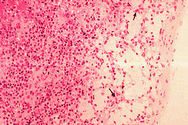 Identify the cell at the tip of the arrow:
Identify the cell at the tip of the arrow:
A) lymphocyte
B) reticulocyte
C) epithelioreticular cell
D) macrophage
E) reticular cell
Question 3 - Single Best Answer
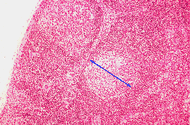 Identify the structure at the tip of the arrow:
Identify the structure at the tip of the arrow:
A) medullary cord
B) white pulp
C) red pulp
D) medullary sinus
E) germinal center
Question 4 - Single Best Answer
A) thymus
B) spleen
C) lymph node
D) parathyroid
E) tonsil
Question 5 - Single Best Answer
 Identify the cell at the tip of the arrow:
Identify the cell at the tip of the arrow:
A) macrophage
B) reticulocyte
C) epithelioreticular cell
D) reticular cell
E) lymphocyte
Question 6 - Single Best Answer
 Identify the cell at the tip of the arrow:
Identify the cell at the tip of the arrow:
A) reticular cell
B) epithelial cell
C) reticulocyte
D) smooth muscle cell
E) lymphocyte
Question 7 - Single Best Answer
 Identify the structure at the tip of the arrow:
Identify the structure at the tip of the arrow:
A) trabecular vein
B) postcapillary venule
C) central artery
D) venous sinus
E) Hassall's corpuscle
Question 8 - Single Best Answer
A) thymus
B) thyroid
C) tonsil
D) lymph node
E) spleen
Question 9 - Single Best Answer
 Identify the structure marked by the dots:
Identify the structure marked by the dots:
A) white pulp
B) medullary cord
C) venous sinus
D) medullary sinus
E) splenic cord
Question 10 - Single Best Answer
 Identify the structure at the tip of the arrow:
Identify the structure at the tip of the arrow:
A) central artery
B) Hassall's corpuscle
C) venous sinus
D) trabecular vein
E) postcapillary venule
Question 11 - Single Best Answer
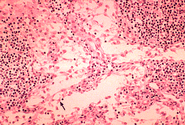 Identify the cell at the tip of the arrow:
Identify the cell at the tip of the arrow:
A) epithelial cell
B) reticular cell
C) epithelioreticular cell
D) macrophage
E) lymphocyte
Question 12 - Single Best Answer
A) lymph node
B) tonsil
C) thymus
D) spleen
E) parathyroid
Question 13 - Single Best Answer
 In this slide of the lymph node, identify the cell at the tip of the arrow:
In this slide of the lymph node, identify the cell at the tip of the arrow:
A) macrophage
B) reticular cell
C) endothelial cell
D) smooth muscle cell
E) lymphocyte
Question 14 - Single Best Answer
 Identify the structure at the tip of the arrows:
Identify the structure at the tip of the arrows:
A) medullary cord
B) splenic cord
C) venous sinus
D) white pulp
E) medullary sinus
Question 15 - Single Best Answer
A sixteen year old female presents to the emergency room after a motor vehicle accident. Before losing consciousness, she complained of abdominal pain localized to the left upper quadrant. The EMS staff tells you that her blood pressure had been dropping during her ride to the hospital. Because of your astute histology background, you decide to do an ultrasound and cat scan because you remember that the spleen has an open circulatory system and she may be losing blood because of a splenic fracture. Your suspicions are confirmed by the radiologist. You call the general surgeon on call because your patient has lost consciousness and her blood pressure is 70/40. From an immunological stand point, should you worry about removing the spleen of a 16 year old?
A) yes
B) no
Question 16 - Single Best Answer
Surgery is complete and their are no complications. What is the best way to prevent infections in this patient?
A) No intervention is necessary.
B) Give the patient the necessary components through the transfusion of blood products.
C) vaccinate
D) do a splenic transplant
Question 17 - Single Best Answer
A cystic hygroma is a tumor composed of abnormal growth of lymphatic vessels and tissue. It is a rare tumor and can be found anywhere within the body. Which site would be immediately life-threatening to a patient, once the tumor becomes a substantial size?
A)
B)
C)
D)
Acute leukemia is a tumor in which the blood and bone marrow have an abundant number of immature cells, aka "blasts". The blood normally has mature cells and the bone marrow has immature cells, but not in such great number. Here are photos of leukemia. Notice the large, heterogenous nuclei. 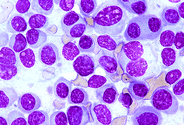
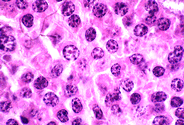 There is not supposed to be a question here, this is just for interest. Just what you need before the test, right?
There is not supposed to be a question here, this is just for interest. Just what you need before the test, right?
Question 18 - Single Best Answer
A 56 year old female presents with anemia, back pain and hypercalcemia(increased amount of blood calcium). She is diagnosed with multiple myeloma, a cancer in which the plasma cell population takes over bony structures. Here is a photo of it. Notice the negative Golgi bodies in close proximity with the nuclei. 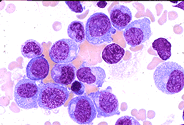 According to the pictures, which is the plasma cell?
According to the pictures, which is the plasma cell?
A)
B)
C)
D)